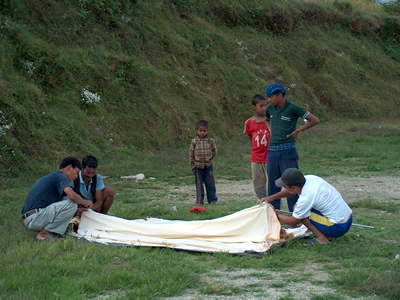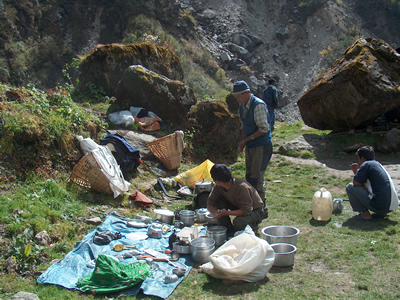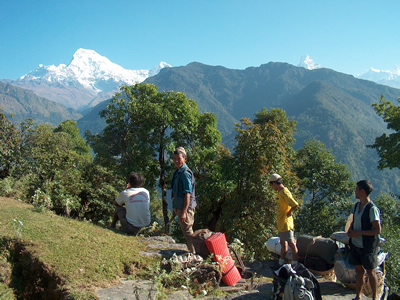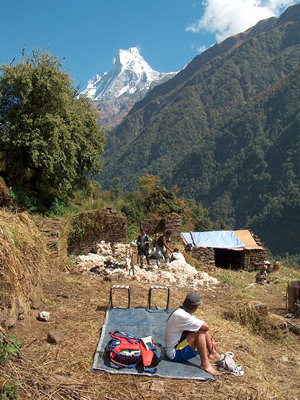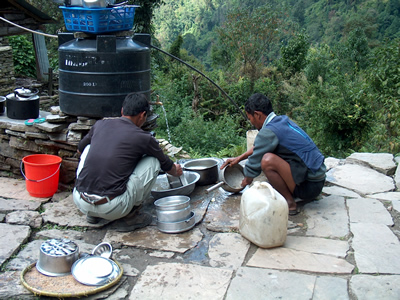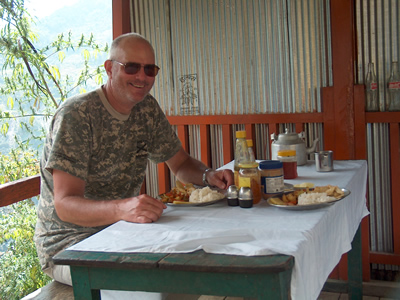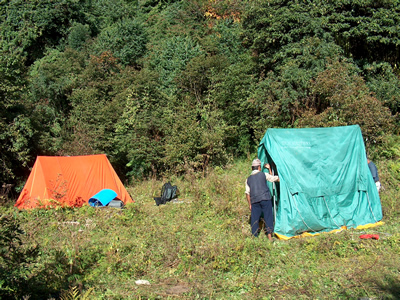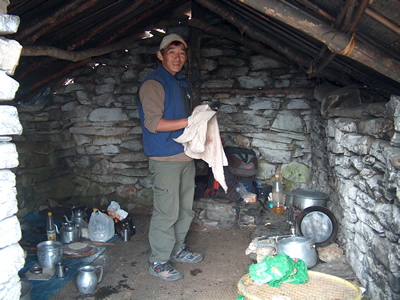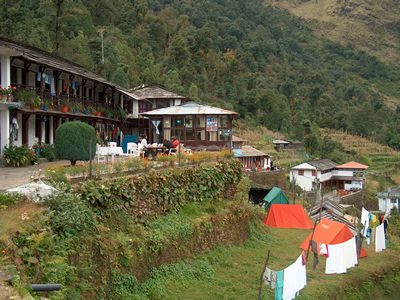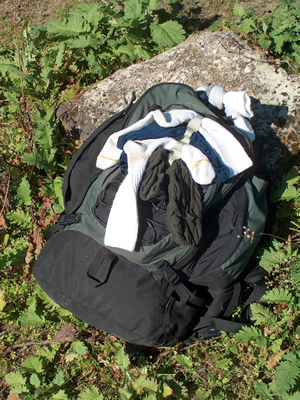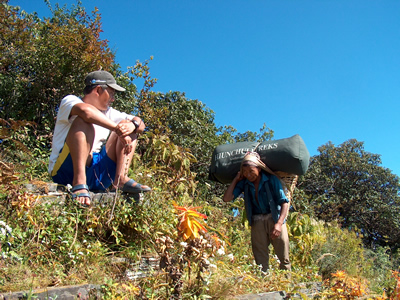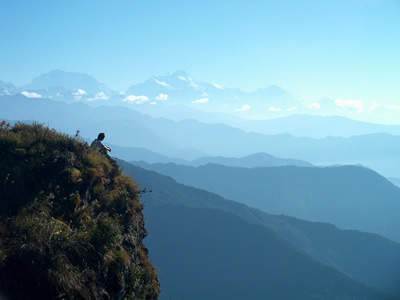A Typical Day On The Trek
I thought that I would deviate from the strict chronological description of my trek and insert an interlude here. Most people have been hiking but a lot of people have not lived in the mountains for an extended time the way you do on a trek. I'll try to describe it and to answer some of the common questions about dealing with the lack of the usual creature comforts of home.
On a trek the day usually starts with one of the cook staff coming to your tent to wake you up with a hot cup of tea. You don't have an alarm clock so this serves as your wake up call. Since I am not much of a tea drinker I changed this after the first day or two. I was more worried about spilling the tea in my tent so I told them to hold the tea till breakfast. I might have changed my mind if the weather hadn't been so warm. Up high on cold mornings a hot cup of tea is helpful when you are trying to convince yourself to leave your warm sleeping bag. But on this trip it really wasn't a problem. I just told Tasi that if he didn't hear me rummaging around in my tent at the appointed time he should give me a holler. It turned out that I always woke up on my own.
When I got up I would get dressed and climb out of the tent. It helped that except for our one day at Annapurna Base Camp in the Sanctuary, it was never very cold in the morning. After a trip to the toilet I would brush my teeth and then climb back into the tent. I would put away my sleeping bag and all my other nighttime gear - book, warm cap, headlamp, pillow, etc. Everything that I wouldn't need during the day's hike went into my duffle bag for a porter to carry. The things that I wanted along with me went into my daypack. Usually I just hiked in a tshirt so I carried a long sleeve shirt, a GoreTex shell, a light jacket, a warm hat, my camera and sometimes a book to read over our lunch break. I might also carry a granola bar for a trail snack, aspirin and stomach medicine and most importantly, toilet paper. Sometimes I carried the laundry for the day (more on that later). It was a fairly heavy day pack but not as bad as carrying a full backpack for a weekend of camping in the mountains back in the US. Since it was so warm there were no tough decisions to make in the morning. Usually wearing just a long sleeve shirt was warm enough for eatinig breakfast and the short time around camp before starting to hike. On my last trip to Nepal when we had cold mornings it was a tough choice. Wearing lots of clothes so that you were warm in camp meant that you had to carry them in your pack all day. Throw them in your duffle and you froze until you got started hiking and the exercise warmed you up. But no such tough choices this time.
It usually took me about half an hour from crawling out of my sleeping bag until I had everything packed and was out of my tent. Then it was time for breakfast. The first day or two we had oatmeal, toast with jelly or honey and pancakes with tea or orange drink. That was way too much food for me. At home I don't even eat breakfast. So I changed the menu to just a piece of toast and some tea or juice. It was nice being the only person on the trek and having everything tailored to just how I wanted it to be. Better than Burger King.
While I was eating breakfast the camp was taken down and packed up for the days hike. Then I filled up my water bottle. Clean water is a bit of a problem in Nepal. You can get some nasty stomach problems (translation - bad diarrhea) from contaminated water. So all drinking water was boiled. Our camp always had a big pot of water boiling which we could use for making tea or juice drinks. I also filled my water bottle from it for all of my drinking water on the trail or in camp. I even used the boiled water for brushing my teeth. It was a minor nuisance but well worth it to avoid having stomach troubles. By using reasonable caution I avoided any stomach problems on this trip.
We usually started hiking around 7:00 or 7:30. Tasi and I would set out with the porters. The kitchen staff stayed behind to clean up dishes. They would have to hurry during the morning to catch up with us by lunch time. But we hiked at a pretty leisurely pace. We would stop fairly often. This let the porters, who were carrying heavy loads (usually uphill) to get a rest. When I hike I usually keep moving and don't stop for a lot of rests. But on a day hike I have a specific destination and I am usually anxious to get there. And on the way back you are heading for your car. When you are finished you drive home or stop for a pizza and a coke. But on this trip I wasn't hiking to a place. I was hiking to be hiking. Much more Eastern than Western. It's about what you are doing, not what the end goal is. So it was nice to take lots of rest stops to look at the view and just to enjoy being in the Himalayas.
And I stopped to take lots of pictures. I ended up with about eight hundred pictures from the trip. My camera had required some thought. Of course I have a nice, small, light digital camera which takes great pictures that I use on most of my trips. But it has a rechargeable battery that only lasts for a day or two without recharging. Obviously on the trek I wouldn't have anyplace to plug it in. So instead I took my older HP850 digital camera. It used four AA batteries. I paid extra for heavy-duty lithium batteries (a trick I learned in the Andes in Bolivia) and they lasted until the very last day of the trek. And I even used the display quite a bit at night to review and edit the days pictures. So that worked well. The HP850 also has a 7:1 optical zoom compared to the 2:1 or 3:1 that most pocket-sized digital cameras have. Much better for wide-angle mountain vistas. I even have a polarizing filter for it which really comes in handy for outdoor scenery shots. But it was big and heavy. That is a drawback when you have to carry it every minute of the day and every place that you go along with a spare set of batteries to be safe. In the mountains, every ounce that you carry adds up. But it worked well and I got a lot of good photos.
We usually hiked for three and a half to four hours every morning. That was always the best time as the views of the mountains were completely clear. We would reach our lunch place around 11:00 to 11:30. Sometimes we would just stop in a clearing. We had a big tarp that we spread on the ground and I could sit there. Sometimes we would stop at a lodge or tea house for lunch. The cook staff made the food but Tasi would pay the owner a small fee to let us use their tables and chairs while we ate. This was actually a good arrangement. The people who do lodge trekking have to buy their meals at all of the restaurants along the way. Althought they do a much better job with sanitation these days, it only takes one cook who is sloppy to cause you a lot of trouble. The cook staff on my trek took great care with hygiene and I trusted them. As I said, I had no stomach problems at all on this trip.
Lunch was always good. There was usually rice or pasta. I got to like a Tibetan dish called momo that is similar to ravioli or tortelini - some kind of filling wrapped in a pasta shell. The cook would buy vegetables from the local farmers and use them as the filling. They were really good. There were also usually cooked vegetables, sometimes flat bread or pancakes, and some kind of small canned meat side dish like tuna or small hot dogs or some cheese. The only thing I got on the whole trip that I didn't care for was sardines on the very first day. But when I said that I didn't like them they disappeared from the menu. The cook staff asked about buying a chicken along the way for fresh meat but I voted against that. Although they were all farmers and I'm sure knew about butchering and preparing a chicken it seemed safer to just pass. I'm not a big meat eater anyway. The lunches were always good and were quite varied. Impressive given the limited kitchen setup. Everything had to be made on two gas camping burners.
Tasi and I would usually eat lunch together. Then when we were done the cook staff and porters would eat their lunch. Then all the dishes had to be cleaned. That took a while so I usually had a lot of time to relax after lunch before we started hiking again. Lunch was usually about a two hour break. But that was a good thing. It broke up the days hiking. It provided a good rest before starting another long hike in the afternoon. And it gave me plenty of time after eating before heavy exercise. I usually read my book or took pictures or enjoyed the view or did some chores like laundry. Or sometimes I just did nothing. We had wonderful weather on the whole trip and no real problem with insects so it was very pleasant just to lounge around in the sun for a while before starting to hike again.
We usually started our afternoon hike around 1 pm and would go for about three hours. I didn't have quite as much energy in the afternoon but the only day I really got tired was day four. Each day had seven to eight hours of hiking and that was about right.
When we reached our campsite the staff set everything up. I didn't have to do anything. It was quite luxurious actually. I would usually take some time to clean up or just rest if the hike had been hard. Around 5 pm we would have tea and biscuits (American translation - cookies). Then we had another break that I usually used to explore the area or to do chores. Then dinner was at 6:30 or 7:00. It was similar to lunch with some additional menu items. We always started with some kind of soup. A couple of nights we had pizza. A few nights we had popcorn but I had to be really careful as there were always some unpopped kernals. Sometimes we had poppadoms as a side dish. I hadn't had them since I lived in England so they were a treat. Sandy doesn't like Indian food so we don't ever go to Indian restaurants. And usually there was some kind of fruit for dessert, either canned fruit or a fresh apple. The food was really good but there was always too much of it. Since the cooks and porters ate after Tasi and I, I sent the extra food to them. It always disappeared pretty fast.
We had a small dinner tent. We didn't use it for lunch because it was too much trouble to unpack the porter loads and set up. But it was always set up in our camp and we used it for dinner and breakfast the next morning. We had two small folding stools and a small folding table for our "dining room". We also had an LED lamp that ran on batteries that we hung from the top of the tent. The tent was about five feet on a side but about six feet high so it was possible to stand up in it. It worked quite well for meals.
It usually got dark about 7pm so it was night by the time we finished eating dinner. While the staff ate I usually just stayed in the dinner tent and read. Around 8:00 or 8:30 they would finish dinner and cleanup so I would get out of the dinner tent and climb in my own tent. There was a second tent like the one I used and Tasi and two of the porters would sleep in that. The two cooks and the other porter would sleep in the dinner tent if their wasn't anywhere else for them available. A lot of times when we camped just outside of lodges though there would be a cooking shed and if so they slept there instead.
I had it pretty good with my own tent. I could spread out as much as I wanted. I could take my duffle bag in so all my gear was inside with me. I didn't have to worry about disturbing anyone if I had to get out for a trip to the toilet in the middle of the night, nor was there anyone to disturb me. And if there was a lumpy spot on the ground it was easy to shift over to avoid it. There was only one night on the whole trek that the ground was uneven enough to be a problem. Most nights I slept really well. When I climbed in my tent I usually spent some time organizing my gear, checked the pictures from the day, and maybe read some more. I would go to bed sometime between 8:00 and 9:00 so I got plenty of rest even though we were getting up early. It was actually very comfortable. I was really happy with the choice I made to do my own trek and to go with the camping approach.
That pretty much describes our routine everyday. But when I talk to people about the trek there are always practical questions that come up about some aspects of trekking, about how you deal with certain things when you are away from the comforts of home. I'll try to cover them here. If you don't want to know about it, this is a good place to stop reading today.
I already talked about food and water and they are not a big deal if you just use some caution. And I did have Cipro with me which still does a really good job of getting rid of most gastrointestinal bacteria very quickly. Thirty years from now it might be a different story. Evolution sucks. But there were three main health/hygiene/comfort issues that I had to deal with on the trek.
The first one is clothes. For a two week trek it is not reasonable to carry a full set of clean clothes for every day. But it really wasn't much of a problem. It isn't that hard to do laundry on a trek. If you take quick-drying clothes that are made of synthetics it makes things pretty easy. I had three long sleeve shirts and three pairs of hiking pants. I could wear those things for two or three days without too much trouble. I wore clean socks and underwear and tshirt every day. About four sets were enough to allow me to cycle through while I washed them. That wasn't much of a problem.
Doing laundry is easy. What is tough is drying clothes. The easiest time to do laundry is in the late afternoon when you reach camp. But if you hang stuff up to dry it only has an hour or two before it gets dark. Without any sun that wasn't enough. And leaving stuff out overnight doesn't work at all. They get wetter from the dew than they were when you set them out. I came up with two solutions to that problem. For small stuff like socks and underwear, I just hung them on the back of my pack while I was hiking. The mornings were always sunny and the clothes dried quickly. I didn't win any fashion contests but hey, it worked. The other thing I did was do laundry during our lunch break. If I washed clothes as soon as we stopped for lunch and then hung them out, they usually dryed quickly in the sun. But since the overcast came in for the afternoon it didn't work as well in camp. But bottom line, clean clothes weren't a problem at all.
The second issue is personal cleanliness. While we were hiking on the main trails it wasn't a problem at all. Many of the lodges have public showers that only cost a dollar or two. While they weren't great (actually a few were pretty grungy) they at least had hot water and were better than nothing. Once we got back on the main trail I got a shower at least every other day. When we got to camp at the end of the day I had time to get cleaned up before dinner. That way I could put on clean clothes to wear around camp during the evening. When we were in more remote country at the beginning of the trek I didn't have that luxury. But I could always get a pan of hot water from the kitchen and go in my tent and do a sponge bath. On most treks they bring it in the morning with your wake up tea, but I changed it to the afternoon after hiking. I preferred to feel clean in camp in the evening. Bottom line again, it really wasn't an issue.
Last but not least is using the toilet. A quick break just meant walking a couple of steps off the trail into the woods. Not too tough. But more serious business is different. Sanitation in Nepal is just not very good. In remote areas when we made camp the staff set up a latrine. First they dug a slit about six inches wide, two feet long and about twelve inches deep. Then they set up a small tent over it. The tent was only about three feet by three feet but was tall enough to stand up in. Voila, instant bathroom. They usually set it up some distance away from the main camp. Although not ideal, it worked out pretty well. But when staying in the villages there is nowhere to set up a toilet tent. You have to use the local facilities. And they just aren't very good. Western toilets are extremely rare. I didn't see one the entire time on the trek, although I heard rumors that they could be found in the most expensive lodges. It is pretty much squat toilets everywhere. Almost no one has running water in their house so that means using an outhouse. There is usually a hose that comes in that has a flow of water that runs to a bucket. That fills with water and when you use the toilet you just empty the bucket into the toilet - a manual flush system. Of course they are not very clean. So using the toilet is not the most pleasant experience of the day. But it is only a few minutes so it's really just a minor inconvenience.
So aside from some small annoyances day-to-day life on the trek was really easy and a lot of fun. You are really pampered by the staff. All my meals were prepared for me. All the dishes were done. Camp was set up and taken down. Someone hauled all the gear. The menu and itinerary of the day was under my control. The only chores I had to worry about were keeping myself and my clothes clean. I had my own tent. The weather was great. There was no problem with annoying bugs.
Every day all I had to do was get up and go for a hike in the most amazing mountains in the whole world. I could handle that.
